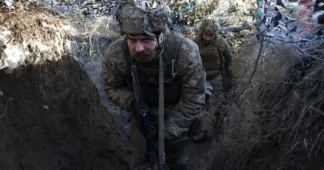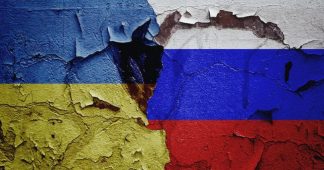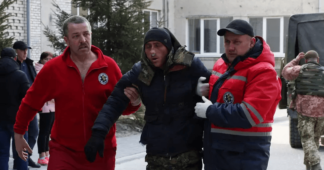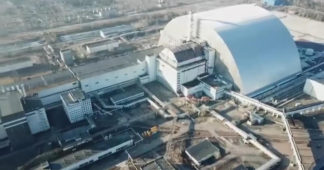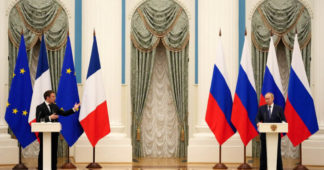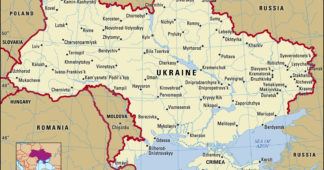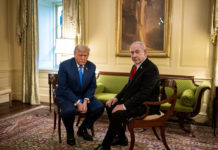Secret CIA training program in Ukraine helped Kyiv prepare for Russian invasion
By
Ukrainian snipers had a problem: Russian forces in eastern Ukraine were trying to blind them.
As the Ukrainians were looking through their scopes in order to find their targets, the Russians had begun pinpointing their location using the glare of the glass, and were shooting high-energy lasers into them, damaging the snipers’ eyesight.
The two sides were squaring off in close proximity. In early 2014, Russia had already invaded and annexed Ukraine’s Crimea peninsula. Shortly thereafter, pro-Russia insurgents in the eastern Donbas region began a grinding secessionist war against Kyiv.
Russian troops soon entered the fray. So, quietly, did the CIA.
As the battle lines hardened in Donbas, a small, select group of veteran CIA paramilitaries made their first secret trips to the frontlines to meet with Ukrainian counterparts there, according to former U.S. officials.
CIA paramilitaries soon concluded that, in Russia and its proxies, the agency was facing an adversary whose capabilities far outmatched the Islamist groups that CIA had been battling in the post-9/11 wars. “We learned a lot real quick,” says a former senior intelligence official — including about the Russians’ laser-blinding techniques. “That s*** wouldn’t happen with the Taliban.”
Since Russia’s large-scale invasion of Ukraine last month — which transformed a long-simmering, attritional conflict into an explosive, all-out war — the Ukrainian military has defied predictions of a rapid collapse, holding key cities against the Russian advance and inflicting punishing losses to Russian troops and materiel.
The Ukrainian military has claimed to have killed three Russian generals, including at least one reportedly eliminated by sniper fire. (Yahoo News could not independently verify whether the Russian commanders were killed by CIA-trained troops.)
At least some of the fierce resistance by Ukrainian forces has its roots in a now shuttered covert CIA training program run from Ukraine’s eastern frontlines, former intelligence officials tell Yahoo News. The initiative was described to Yahoo News by over half a dozen former officials, all of whom requested anonymity to speak freely about sensitive intelligence matters.
The program was run under previously existing authorities for the CIA and did not require a new legal determination for the agency, known as a covert action finding, according to a former national security official.
As part of the Ukraine-based training program, CIA paramilitaries taught their Ukrainian counterparts sniper techniques; how to operate U.S.-supplied Javelin anti-tank missiles and other equipment; how to evade digital tracking the Russians used to pinpoint the location of Ukrainian troops, which had left them vulnerable to attacks by artillery; how to use covert communications tools; and how to remain undetected in the war zone while also drawing out Russian and insurgent forces from their positions, among other skills, according to former officials.
After Russia’s 2014 incursion, the U.S. military also helped run a long-standing, publicly acknowledged training program for Ukrainian troops in the country’s western region, far from the frontlines. That program also included instruction in how to use Javelin anti-tank missiles and sniper training.
Yahoo News reported in January on the CIA’s secret U.S.-based training initiative for Ukrainian special operations forces and other intelligence personnel. That program, which began in 2015, also included instruction in firearms, camouflage techniques and covert communications. Yahoo News’ prior report also revealed that CIA paramilitaries had traveled to eastern Ukraine to assist forces loyal to Kyiv in their fight against Russia and its separatist allies.
U.S. officials previously denied to Yahoo News that the CIA training programs were ever offensively oriented. “The purpose of the training, and the training that was delivered, was to assist in the collection of intelligence,” said a senior intelligence official.
Until now, however, the details of the CIA’s paramilitary training program on Ukraine’s eastern frontlines have never been revealed. This initiative, say former agency officials, has helped battle-hardened Ukrainian special operations forces for the current Russian assault, which has plunged Europe into its worst conflict in decades. (The CIA declined to comment. The National Security Council referred queries to the CIA. The Ukrainian Embassy in Washington, D.C., did not return a request for comment.)
Former U.S. intelligence officials believe the program is still bearing fruit. “I think we’re seeing a big impact from snipers. Especially as Russian forces get bogged down from lack of supplies,” said the former senior official. “I think the training really paid off.”
***
When CIA paramilitaries first traveled to eastern Ukraine in the aftermath of Russia’s initial 2014 incursion, their brief was twofold. First, they were ordered to determine how the agency could best help train Ukrainian special operations personnel fight the Russian military forces, and their separatist allies, waging a grinding war against Ukrainian troops in the Donbas region.
But the second part of the mission was to test the mettle of the Ukrainians themselves, according to former officials. The agency needed to determine the “backbone” of the Ukrainians, said a former senior CIA official. The question was, “Are they going to get rolled, or are going to stand up and fight?” recalled the former official.
The Ukrainians, the CIA paramilitaries reported back to their superiors, were indeed ready for battle.
The CIA operatives taught their Ukrainian counterparts the best skills for irregular warfare, said the former senior intelligence official. “We tried to really focus on operational planning, then really hard military skills like long-range marksmanship — not just the capacity to do it, but to know how to do it on a battlefield, to really deplete the leadership on the other side,” said the former senior intelligence official
Because of the sensitivities of the mission, the agency chose to send experienced, mature operatives, recalled former officials. The thinking was, “one miscalculation, one overzealous paramilitary guy, and we’ve got ourselves a problem,” said the former official. “Everything we did in Ukraine had a chance to be misinterpreted, and escalate the tensions.” Accompanying the more strategic-minded, veteran paramilitaries sent by the agency were tactical specialists, like snipers, who also worked for the CIA Special Activities Center.
But after over a decade focused on the war on terror, the high-tech battlefield environment was a shock to the CIA. Russian soldiers and their proxies were using drones, cell towers and other equipment to triangulate the phones and electronic devices of the Ukrainians and CIA paramilitaries on the frontlines — and then rapidly targeting them with that information, according to former officials.
Ukrainian soldiers “were using mobile phones in a trench,” recalled a former intelligence official. “People were getting blown to bits.”
It was “almost like SkyNet in a ‘Terminator’ movie — that’s what the eastern edge of Ukraine started looking like,” says the former senior CIA official, referring to the malevolent, self-aware, weaponized artificial intelligence system in the Arnold Schwarzenegger films. The Russians’ operations on the frontlines would evolve rapidly in response to the Ukrainians’ and the CIA’s own there, according to former officials.
CIA paramilitaries needed to make quick adjustments, recalled former officials. Agency officials were forced to develop new modes of secure communications systems so paramilitaries could “communicate and then move before you get the direction finding from the Russians” and “they start[ed] rocketing the crap out of you,” recalled the former senior official.
The CIA had to solve the tradecraft challenges that arose from working in eastern Ukraine. The environment was unique, where “Moscow rules” — that is, the need for extreme operational care, because of the Russians’ counterintelligence capabilities — converged with an active war zone.
“We were caught with our pants down,” says the former senior CIA official. But the agency soon developed new tools to ensure that agency paramilitaries could transmit information to each other securely on the frontlines, as well as to Washington, without tipping off the Russians. Agency paramilitaries also shared some of these techniques with their Ukrainian counterparts.
The last thing the CIA wanted was a direct confrontation with the Russians that could explode into a wider conflict. Though the program grew over time, it was kept very small on purpose, with the number of CIA paramilitaries initially sent to eastern Ukraine in the low single digits. This was in order to minimize the agency’s exposure, and to protect the Ukrainians from arousing the Russians’ ire, according to former officials.
And the rules of the agency’s engagement on the Ukrainian frontlines was clear: Advise and train, but do not take part in combat yourself, recalled former officials.
The agency impressed upon the CIA paramilitaries traveling to the front that “the Ukrainians have very effective special operations,” recalled the former senior intelligence official. The directive was, “Your job is to make them more effective.”
CIA officials believed that “just sending six guys to be six snipers is not really going to be something that’s going to affect the battle space,” recalled this official. “Our job is to have an exponential impact; it’s not to get our badge for shooting a Russian or something.”
Still, shortly after Donald Trump took office in 2017, National Security Council officials were concerned that, though the CIA paramilitaries in Ukraine were prohibited from engaging in combat, the parameters of their mission, which had begun under the Obama administration, were ambiguous. “We worried that the authorities might be too far-ranging,” said a former national security official.
One big question was, “How far can you go with existing covert action authorities?” recalled the former official. “If, God forbid, they’ve shot some Russians, is that a problem? Do you need special authorities for that?” White House officials also worried about what might happen if CIA operatives were captured by pro-Russian forces on what was supposed to be a secret mission, recalled the former official.
The discussion about the agency’s program was part of a broader review at the Trump White House of U.S. support for Kyiv — and what Moscow’s red lines might be, recalled the former official. “There was a school of thought that the Russians spoke the good old language of proxy war,” and that the CIA’s covert (as well as the military’s acknowledged) training programs and the U.S.’s overt supplying of weapons to Ukraine were therefore within historically acceptable bounds, the former official said.
CIA leadership and White House officials both understood — but still fretted over — the risks. “I don’t know how we didn’t get anybody injured, to be honest,” says the former senior intelligence official. But the covert nature of the mission ensured deniability. U.S. officials “wouldn’t want to say, We just had a CIA officer killed by a Russian” in Ukraine, recalled the former official. “That would put the president or the White House in a very bad position.”
The Ukraine-based CIA program operated for years, according to former officials. But as the threat of a large-scale Russian invasion became increasingly acute last month, the Biden administration, still feeling the sting of the Afghanistan withdrawal, pulled all CIA personnel out of the country, including war-zone-hardened agency paramilitaries, according to a former intelligence official in close touch with colleagues in U.S. government.
The administration was “terrified of even clandestine folks being on the frontline,” says the former official.
But even if the CIA’s cadre of paramilitary trainers are no longer in Ukraine, the effect of the agency’s training programs — both in the U.S. and on Ukraine’s eastern front — “cannot be overestimated,” said the former senior CIA official. These elite units trained by the agency have created “a strong nucleus” for Ukraine’s larger military forces today, according to this official.
In addition to the hard skills these operatives are bringing to the fight with Russian troops, some of the benefits are more intangible, according to former officials. The CIA-trained special operations units set an example by “getting some small wins” and by “providing some success stories” for the larger Ukrainian military, says the former senior official.
Courage can be contagious, notes the former official. So then, empowered by their comrades’ victories, “you get people that are charging to the sounds of the gunfire.”
Published at news.yahoo.com
We remind our readers that publication of articles on our site does not mean that we agree with what is written. Our policy is to publish anything which we consider of interest, so as to assist our readers in forming their opinions. Sometimes we even publish articles with which we totally disagree, since we believe it is important for our readers to be informed on as wide a spectrum of views as possible.
